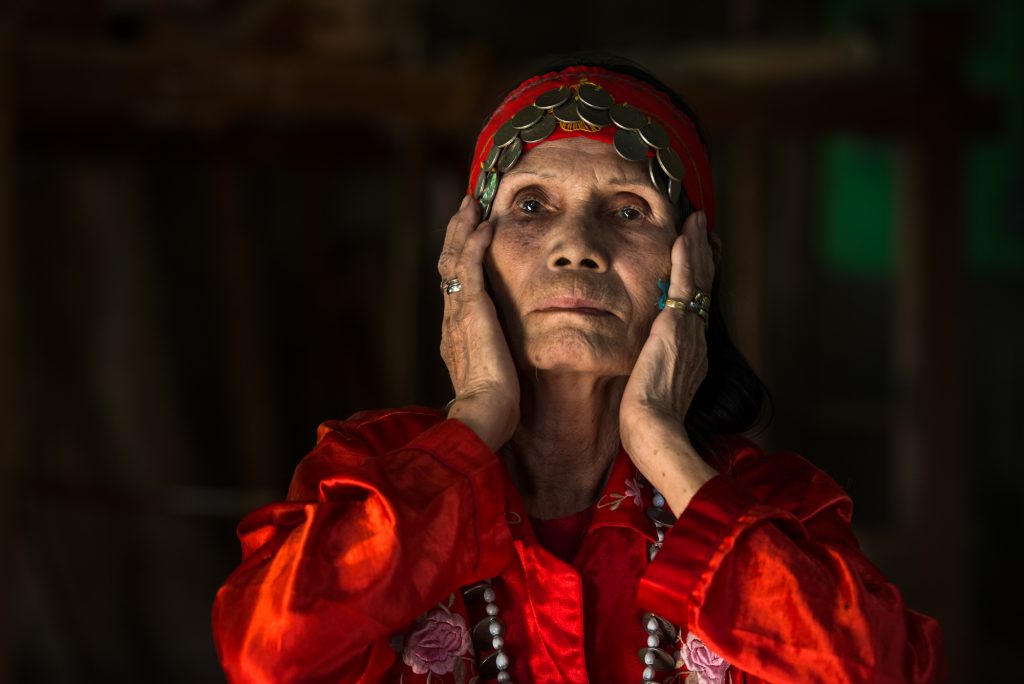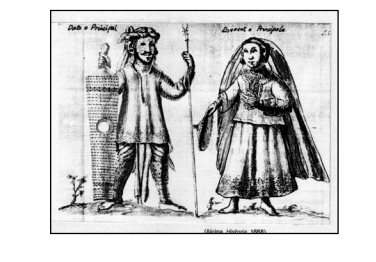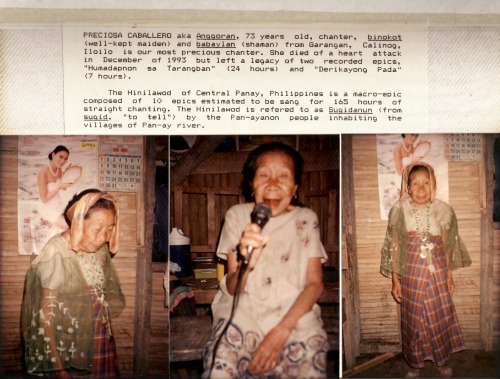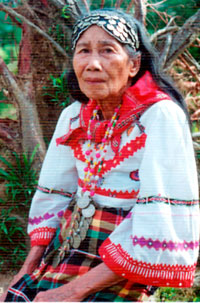“A very select group of women existed in indigenous Philippine society which has hardly merited any account in history. These women were daughters of datus or rulers who were kept hidden in special rooms and were not allowed to be seen by any man. They remained secluded from society but their beauty and prestige were widespread. Their seclusion contributed immensely to their near invisibility in history, except that their presence dominates the narratives of almost all the Philippine epics. In these epics, these secluded women are described in length, from their physical beauty to their abilities in the spiritual realm. The description of these young women, desired by warrior-heroes and rulers as their wives, are an uncanny guide in a closer reading of the historical texts where we find glimpses and hints of their presence once their characteristics are discovered from the epics.” ~ MARIA BERNADETTE L. ABRERA

The Practice
Binukot is a Filipino cultural practice that secludes a young person (all known accounts are of a young woman) with the expectation that seclusion will result in a higher value placed on the individual by marital suitors in the future. The practice originated in the pre-Hispanic Philippines but continues to this day. It was most recently practiced by the Panay Bukidnon people, who keep women from the public eye beginning in childhood. The Binukot is isolated by her parents from the rest of the household at 3 or 4 years old. She is not exposed to the sun, not allowed to work, and is even accompanied by her parents when she takes a bath. This results in a fair, frail, fine-complexioned, and long-haired woman. As she stays at home most of the time, her parents and grandparents entertain her with various oral lore and traditional dances. This makes the Binukot excellent epic chanters and repositories of their history.
Tradition persists that the Binukot must not be seen by any man from childhood until puberty. Only the family members and the female servants, called apid, may come face-to-face with her. In order to keep her away from men’s eyes, as well as shield her from the sun, she bathes in the river in the evening. A makeshift enclosure may also be made for her in the river for this purpose. No man would dare to look at a Binukot as there is a threat of punishment by death to anyone who violates her by looking.
A Binukot is not allowed to do heavy work but may weave in her room. She is provided female servants to do other work for her.
When a Binukot is ready for marriage at 13 or 14, or even younger, her parents ask for a high pangayu (bride price or dowry) from the family of the suitor. Jealously and zealously guarded, the maiden, with her beauty and high pangayu, brings prestige to the family and livestock. Even when the suitor visits her, the parents do the entertaining and she is kept inside her room—but she can show the tip of a fingernail. However, though very occasionally, she is bought by her parents to big gatherings such as weddings where young men could appreciate her beauty and she could perform a ritual dance.
Where this practice came from is largely unknown. No extensive comparative studies on the subject have been done in other animist SE Asian communities. Some speculate that it may be tied to the Islamic practice of veiling, although I suspect it has closer ties to the related, yet earlier, Indian/ Hindu practice of “purdah” which restricted women’s social mobility and behavior. Some scholars argue that purdah was initially designed to protect women from being harassed, but later these practices became a way to justify efforts to subjugate women and limit their mobility and freedom. However, others argue that these practices were always in place as local custom, but were later adopted by religious rhetoric to control female behavior. Which view is taken would be greatly dependent on when the practice arrived in the Philippines. This proves challenging because evidence is not only sparse but limited in time, appearing only in the colonial sources.
In the 18th century, the story of a Polynesian expedition was widely known only through the sometimes imaginary account of a young officer, Carl Friedrich Behrens, whose narrative was published in German and in French (Behrens 1739). Concerning the discovery of Easter Island, Behrens’s narrative contains crucial supplementary pieces of information, but he has nearly nothing to say regarding contact with the Samoans. Although the facts are few, the lesson from that very first contact is rich. The only woman in sight was an adolescent sitting beside the main Chief, on a canoe that came to meet the visitors. We do not know if she made any specific gestures or if she remained motionless. She could have been a young wife of the Chief. But, if we are to judge from similar situations in the 19th and 20th centuries, a young female accompanying a chief (ali’i pai’a) who comes to greet visitors or enemies was a daughter or sister (real or classificatory), one of those girls referred to in the later literature as ‘village maiden: taupou’ (more precisely, in Samoan honorific vocabulary, a tausala, augafa’apae, saotama’ita’i). If Behrens’s noting of the particularly fair colour of the girl’s skin is valid, it would be a further proof that this girl was a tausala, as those high-ranking official virgins were kept very secluded inside their houses. Later ethnography has noted this pan-Polynesian practice as it applied to high-ranking females. The thinking behind it was for the girls to avoid sunburn and remain as white as possible (and even enhance their whiteness by getting very fat and having the skin distended). The practice had both a cosmological and a social reference. Cosmologically, the light of the sun was valued over darkness as the sign of life (ao versus po). Socially, avoidance of the sun was a sign of superior rank. The sun’s rays blind other people, obliging them to keep their eyes down and bow their heads. Dark skin denotes someone who is working outside and thus is exposed to the sunlight (fishing, tilling the garden, preparing the food), while fair skin denotes the person of chiefly rank who stays inside and is served food by others.
It has also been noted that the Javanese aristocracy engaged in the practice of secluding their daughters while waiting for an arranged marriage.
The above accounts, while inconclusive of any answer, are evidence enough to warrant further investigation and comparative studies to see if this practice was conducted among other Austronesian language groups and pre-dates any Indianized or Islamic encounters.
Image of a Binukot
Binukotan (plural for binukot) are describe in epics and tales using metaphors such as, visage of the sun, appeared like the sun, shone like a star, pale as the moon, and incomparably beautiful, which suggests that the Binukot is a standard of aesthetic beauty.
A Binukot is said to be the most beautiful maiden in her community. She is a fair to white complexion, and is dressed in an ankle length skirts and long-sleeved blouses that appear to be richly embroidered (Panubok) at the collar, cuffs, and hem.
The Binukot of Panay-Bukidnon wears jewelry made from Spanish coins that are strung together and called biningkit, a waistband of coins is called a wakus, and a headdress of coins is known as a pundong.
There is fortunately an historical illustration of this hidden group, from the record of Francisco Alcina of Samar and Leyte in 1668. She is labeled as “binocot ó principala”, indicating that she was a secluded maiden or synonymously, a female member of the principal class. Her ankle length skirt and long-sleeved blouse appear to be richly embroidered at the collar, cuffs, and hem. She is veiled, reaching down to her knees, but her face is shown. She holds a native hat on her right hand. She appears opposite the “dato ó principal”, the male ruler of the community. The datu carries a spear and a long shield, wears a potong or cloth around his head, wears a long sleeved shirt, and appears to be tattooed on his face, neck, and legs. This is an historical indication of the social class of the binukot. She belonged to the elite and was esteemed as equal in rank to the datu or ruler. Datus desired binukot maidens for their wives, a practice that is more than reflected in the epics. William Dampier, cruising Mindanao in 1687, records some snippets which are useful about the practice of seclusion. The Sultan in Mindanao that they visited had many daughters by many women, but it was his one daughter by his wife who was a binukot.

“He has one daughter by his Sultaness or Queen and a great many sons and daughters by the rest. These walk about the streets, and would be always begging things of us; but it is reported that the young princess is kept in a room, and never sirs out, and that she did never see any man but her father and Raja Laut her uncle, being then about fourteen years old.”
The 1668 account of Fr. Alcina gives a description of the physical characteristics of the binukot. The Bisayan women, he states, are “more fair in complexion… even more especially the principalas who are called binocot.” To Alcina, binocot meant to remain at home, which was why in their isolation and seclusion they had “white features… as fair as the Spanish women”.
The fairness of the binukot is likewise seen in the Visayan Epic, Labaw Donggon. His three wives, all binukot from their own respective worlds. Of the first wife, her complexion was compared to the hikay, a large white shrimp, as well as to the balanak fish that is known for its white meat. Her legs were smooth and flawless, sleek like a banana trunk, and as white as the bamboo when split open. His second wife, a binukot from the world under the earth he saw in a dream, whose sway when she walked resembled the movement of the treetops in fluidity. Her skin was fair like the balanak and flawless too as a banana trunk, and was renowned in the use of weapons. The third wife was carefully watched over by her retinue of servants while she slept in a hammock as her husband had strictly instructed that that no fly should be allowed to come near to disturb her rest. The radiance of their beauty was renowned and brought men to seek them out.

In the Boholano epic, Bugbung Humasanun was “the most renowed among all the beauties…(who was) so secluded and enclosed in her chamber that nobody ever saw her except by sheerest chance. Her visage was like the sun when it spreads its first rays over the world or like a sudden flash of lightning, the one causing fear and respect, the other, joy and delight.” So desired was this binukot of great reputation and fame that she was sought particularly by a great chief, Datu Sumanga. However, the bunukot obviously knew her great value so that she managed to rebuff his suit and require him to go on several mangayaw raids, as far south as Jolo and as far north as China, receiving each time the spoils and captives he obtained from these lands.
The Binukot’s Room
To keep the daughters secluded meant having a separate room for them. This is evidenced in the Maranao epic Darangen where the “princess”, or liyamin, makes her home. The Maranao term for her is actually liyamin, literally, one who lives in the lamin. Her name classification is derived from the tower or lamin where she is kept. She lives in the lamin of the torogan or royal house with her female consorts who assist her and keep her company. Growing up in a bokot, or room, the secluded daughter most often passes her time doing weaving and eventually embroidery. Almost all the clothes of the men in her family are woven by the binokot, from her father to her brothers. The epic hero usually has his clothes done by his sister. In the Darangen, the liyamin occupies herself with weaving. The lamin itself, as described in the epic Darangen, resembles a tower similar to that pictured in a book on Philippine architecture . The lamin is a larger room than the gibon and it is located above the torogan or royal house.
The inspiration for the design comes from nature: what is around them, including the colors used. A usual embroidery design is the banog, hawk. From field data in Panay, the binukot does tubok or needlework. By tradition, the Visayan binukot is not given heavy work such as planting, but remains in her room to weave.
In the Maranao epic, Darangen, there is a mythical boat that can accommodate the entire community with all its buildings and there is a special place for the binukot. In the middle of the boat is a special tower made of glass specifically for the Princess and her ladies. This is symbolic of the power and the prestige accorded to the binukot. It is through the structural description of the lamin as tower, where the liyamin spends her time weaving clothes and linen, that we are able to interpret the late 16th century document of the Jesuit priest Pedro Chirino, where he states:
“Not until we went to Taitai did I learn that in many of the houses there was another one, but smaller, made of cane, as it were a little tower, fashioned somewhat curiously, to which they passed from the main house by a short bridge… In these were kept their needlework and other works of handicraft, by means of which they concealed the mystery of the little house.”
Etymology
The general term for this group of women is binukot, a word which is still used in the Philippine island of Panay. Its root, bukot, is denoted as “be blanketing, be swaddling oneself” while bukotán is a verb that means “to blanket, swathe, swaddle” much like an infant or a sick person.
Francisco de San Antonio (1624) who recorded one of the earliest vocabularies of a Philippine language, indicated that the Tagalog bocot meant encerramiento como monja (to be cloistered, like a nun). This was repeated in the 1754 vocabulary list of Noceda and Sanlucar, bocot: encerramiento como de monja. Both the 17th and 18th century Tagalog vocabularies indicate a second meaning for bocot as a noun, which was un cesta tegido de palma, a basket woven from palm leaves; pagbocotan was where it was put, while the bocotan and sangbocot both meant un cesto (a basket). This would be related to the use of the word bocot meaning “to entrap” such as an animal or a fish, which is still current in the Kiniray-a language in Panay island. Alonso de Mentrida (1637), writing on the languages in Panay, defines the root word bocot as “to have daughters who do not go down from the house, or to have them in seclusion: the room or the retreat”. In another Philippine language, Bicol, bukot had a synonymous meaning in the 19th century, “to cloister daughters so that they do not leave the house, as practiced in the olden days”. Binobocot further meant to be cloistered and placed in a clausura or secluded place, while either the place of seclusion or the trap itself was called the binobocotan.
From various historical sources American anthropologist, William Henry Scott gives the general impression of the binukot as a lady or a royal princess who is secluded and inaccessible. Their high position in society lends their name to a type of small, fragrant banana called “todlong binokot” or ladyfingers.
Known Binukot
Hugan-an – Hugan-an was a singer/chanter of the epic poem Hinilawod of the Central Panay, Philippines. She retold and recorded the 30-hour-long Hinilawod epic while folklorist F. Landa Jocano recorded it.
Hinilawod is a 29,000-verse epic that takes about three days to chant in its original form, making it one of the longest epics known, alongside that of Tibet’s Epic of King Gesar. Hinilawod is one of the many pieces of oral literature passed from one generation to the next, changed and morphed by the chanter to one degree or another as he told it to his audience. The Hinilawod is not just a literary piece but also a source of information about culture, religion and rituals of the ancient people of Sulod; showing us that ancient Filipinos believed in the “sacred,” in the importance of family honour and in personal courage and dignity.
Hinilawod was first discovered “by accident” in 1955, when Filipino anthropologist F. Landa Jocano became interested in native folklore. He travelled the hinterlands of his home island of Panay with two colleagues collecting folk songs, stories, and riddles. It was during one of those trips to the upland barrios of Lambunao, Maasin, Janiuay, and Calinog in Iloilo that his attention was called to a long and popular tale called Hinilawod. Portions of the story were sung to him and his colleague by an old man called Ulang Udig.
Returning the following year with a radio technician from Central Philippine University, he then recorded a portion of the story on tape in 1956. However, when he returned, in 1957 to make a recording of the complete story, Ulang Udig could only recount the Epic of Labaw Donggon; he could no longer recount the much larger Epic of Humadapnon. Weeks later, Ulang Udig introduced Jocano to his aunt, an old babaylan named Udungan. However, the old babaylan could only chant little portions of the Humadapnon Epic. Jocano was then introduced to Udungan’s niece, mountain singer named Hugan-an, who, after much cajoling, allowed herself to be taped recounting both her story and the Hinilawod. It took three weeks to complete the recording of the 30-hour epic poem.
A concise version of the story of Hinilawod can be found in the book Philippine Mythology authored by Jocano.

Anggoran (Christian name: Preciosa “Susa” Caballero) – Preciosa, also known as ‘Susa’ or Anggoran, her native name, was a 73 year old babaylan, (priestess) and epic chanter from the Barangay, Garangan, in Calinong, Iloilo, Panay who passed away in December of 1993.
She is one of the many epic chanters to be recorded and contributed in the help of preserving epics from Panay. On a journey and mission to record 9 other epics following the Filipin@ folklorist and anthropologist, Dr. Felipe Landa Jocano, Alicia P. Magos from the University of the Philippines in the Visayas, with her research assistant and guide, and with funding from the French government, met Anggoran and from August to November of 1993, Anggoran was recorded when she spoke lines of two epics, Humadapnon sa Tarangban (which is recited for 24 hours) and Derikaryong Pada (recited in 7 hours).
During those months she would sing lines from the epics for 10 minutes at a time and would rest. Due to her old age Alicia Magos gave her plenty of time to chant at her leisure. Anggoran would chant when she felt like it and was inspired to, at times waking up at dawn around 4 in the morning to chant and be recorded.
At the end of November of 1993 she finished recording both the epics, but unfortunately she passed away in December of that year leaving at least 2 other epics she knew about and spoke of to be unrecorded.

Rosita Silva Guillermo Caballero – Rosita was the last “secluded maiden” or “binukot” of the Caballero family from the Panay Bukidnon tribe in Calinog, Iloilo and passed away on July 23, 2017 at the age of 74.

Elena Gardoce – Gardoce is known in cultural circles because of an award from the Cultural Center of the Philippines for story-telling in the dialect. Lola Elena Gardoce was also once a binukot. She passed away at age 98.
Conchita Gilbaliga – Lola Conchita, whose real name is Conchita Gilbaliga is Panay Bukidnon’s binukot from Nayawan, upland Tapaz, Capiz. She was 83 as of 2009.

Living Traditions
During WWII, many mountain residents on Panay needed to flee their homes; and the binukots, who were too frail to run and were not allowed to be seen were left behind. It is suspected that many of them ended up as “comfort women” for the Japanese soldiers. This apparently saw the number of Binukot decrease significantly, along with potentially undocumented epics. Since then, the Binukot practice has evolved and to the current generation to be more reflective of current times for the Panay Bukidnon. It is not known whether there are still existing binukots elsewhere in the Philippines. With the threat of vanishing oral heritage, Frederico Caballero, son of a binukot established the balay turun-an, small schools that teach these oral traditions and dances to children. As of 2004, there were only seven known remaining Binukots on Panay.
‘Living traditions’ are best described as being in faithful continuity to the past while meeting the needs of the present and thinking about the future. As an urban dweller, I can’t say I am sad to see the Binukot practice, as it was, fade into history. Without a lifetime of cultural context, it is difficult for me to wrap my head around it being anything other than a form of child abuse. That is the challenge of studying different cultures. It is easy to romanticize forgotten traditions, but when they still live among us it becomes more difficult not to criticize it with our ‘modern’ thinking. Still, had this practice died off with so many others at the time of Spanish colonization, we may never have heard the epics of Panay. Still, sometimes honoring a tradition requires that we approach it anew, and I believe that is what the Panay Bukinon are doing with their schools.
SOURCES:
Panay Bukidnon’s last ‘binukot’ – by: Kelly Austria – @inquirerdotnet Inquirer Visayas / September 29, 2015
Magos, Alicia P. (1995). “The Binokot (Kept-Maiden) in a Changing Socio-Cultural Perspective”. Edukasyon. UP-ERP Journal, UP Diliman
Abrera, Maria Bernadette L. (2008–2009). “Seclusion and Veiling of Women”. Philippine Social Sciences Review. 1. 60
“Lola Conchita, Panay Bukidnon’s “Binukot””. 19 January 2009
Ignacio Francisco Alcina, SJ, History of the Bisayan People in the Philippine Islands 1668, Vol. I
“First contacts in Polynesia : the Samoan case (1722-1848)”, Serge Tcherkézoff, 2008
ALSO READ: Overview of the Sugidanon Epic of Panay
Jordan Clark is a Canadian born descendant of Scottish immigrants living on the homelands of the Lekwungen speaking peoples. His interest in Philippine myth and folklore began in 2004. Finding it difficult to track down resources on the topic, he founded The Aswang Project in 2006. Shortly after, he embarked on a 5 year journey, along with producing partner Cheryl Anne del Rosario, to make the 2011 feature length documentary THE ASWANG PHENOMENON – an exploration of the aswang myth and its effects on Philippine society. In 2015 he directed “The Creatures of Philippine Mythology” web-series, which features 3 folkloric beings from the Philippines – the TIKBALANG, KAPRE and BAKUNAWA. Episodes are available to watch on YouTube. Jordan recently oversaw the editing for the English language release of Ferdinand Blumentritt’s DICCIONARIO MITOLÓGICO DE FILIPINAS (Dictionary of Philippine Mythology) and is working on two more releases with fellow creators scheduled for release later this year. When his nose isn’t in a book, he spends time with his amazing Filipina wife of 20 years and their smart and wonderful teenaged daughter.


